#armorica tips
Explore tagged Tumblr posts
Text
I think the only really solid piece of writing advice I can offer is that the thing that matters most in your writing is your characters' emotional reality. Every descriptive detail you include should serve that end. I have read so many lavish, beautiful descriptions that ultimately convey nothing -- readers can pull up google images if they want to see a sunset, a delicious meal, or a beautiful dress. What's actually relevant is the loneliness the protagonist feels remembering how much her father loved watching sunsets, the comforting warmth of their favorite meal after a trying day, or the fact that the dress makes her feel so beautiful she finally sees herself the way her love interest does.
126 notes
·
View notes
Photo
It looks like mellindi's domain lapsed, so her blog is inaccessible and the link above doesn't lead anywhere anymore.
Here is an archived link to Mellindi's Beginner's Guide to Reshade.
Thank you to the Internet Archive for saving a copy of this resource!

Beginner’s Guide to Reshade A Reshade 4.7.0 Tutorial
Hey! So I’m working on this new series on my blog called the Storyteller’s Series. It’ll be things like tutorials and resources all geared towards those who write or want to write sim stories or post gameplay photos. Content will cover things like installing/using Reshade, scene set ups for photos, editing resources and whatever else I can think of.
I often see others get asks from simmers who want to post their gameplay/stories but are too afraid because they don’t know where to start. I’m hoping this little series can help them and anyone else who needs it.
In this guide, we’ll go over installing Reshade, Reshade presets, MultiLUT, setting toggle keys and the most common shaders used in most presets.
Read Beginner’s Guide to Reshade on my blog
@maxismatchccworld @simblrcollective
722 notes
·
View notes
Text
The Breton Migration
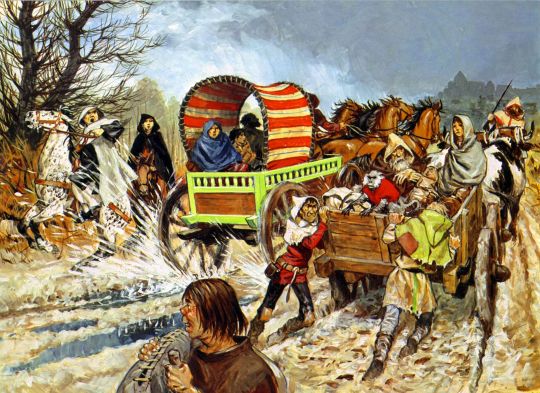
My French Genetics writing got me thinking more about Brittany, and how many academics still believe that the Bretons came from SE Wales fleeing from the Anglo-Saxon invasion. This is due to erroneous medieval assumptions and not historical fact. Our sources on the centuries between the retreat of Rome and the High Middle Ages are very scant, often relying on earlier, possibly faulty accounts instead of direct folk memory, so misconceptions can propagate easily. There is much that we simply can't know. Nonetheless, we have enough to dispel myths and piece together a true story.

The area in question is Armorica, now called Brittany, which is now politically controlled by France. Since the advent of the Celts in Europe, this peninsula has been populated by Armorican Gauls. In the time of Caesar these tribes included the Osimii, the Venetii, and the Curiosolites. We can assume that after the Roman conquest, they lived as typical, if rural, Roman subjects. We can assume they sent their druids to meet in Gaul and Britain with other druids of the area. A Byzantine writer Procopius tells us in the 6th century, that the people of Armorica had the task of ferrying the souls of the dead to Britain. The story goes:
The people of Armorica heard a knock on the door at night, and a low voice calling them. They went to the coast and found boats there weighed down with the souls of the dead, so that the gunwales barely stayed above the water. Leaving from Baie de Depassés at the tip of Armorica, the men would row the boats across the channel to Britain, at which point a voice would call each soul by name, and each soul would disappear when called.
Thus went the druid religion of the Gaulish Armoricans.
But the Empire didn't last forever, and Armorica, being on the far west of the continent, was either thrown around by the political machinations of the Gaulish courts, or so isolated that they weren't even concerned. By 409 the Armoricans, as Zosimus tell us in his "New History",
Encouraged by the example of the insular Britons, had thrown off the Roman yoke. This British-Gallic secession occurred in the time of the Emperor Constantine.
The next year, 410 AD, is when the official retreat of Rome came, and Emperor Honorius told the cities of Britain to "look after themselves." Rome was too weak to hold onto either Britain or, it would seem, Armorica.
We've established the lack of Roman control of Armorica, now we must discover where the new people, the Britons or Bretons, came from.
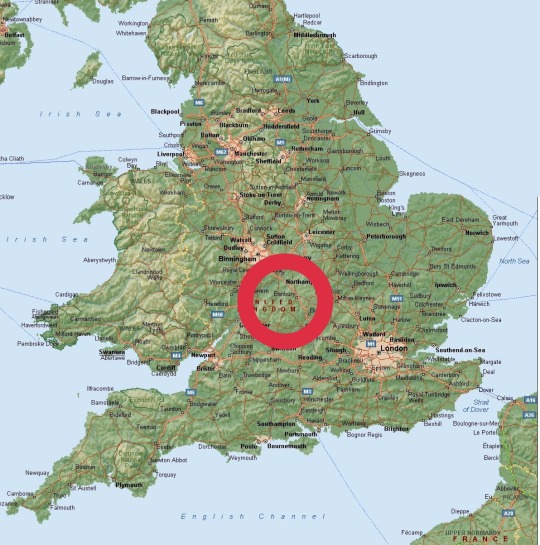

The common narrative is that the Bretons came from central Britain, fleeing from the encroaching Anglo-Saxons; they are essentially Welsh. This idea comes from Gildas (as well as some others, such as Nennius and Eginhard), who said that, 1) the Bretons fled their island from the Anglo-Saxon invaders, and 2) the leaders and generals of the Bretons came from SE Wales. Both of these are misleading. Gildas' account has the Bretons coming from around the above area, and fleeing over the sea through Wales. However, linguists have shown that the Breton language is closest to Cornish, and that many sentence structures common in Breton and Cornish only appear in poetical Welsh. We can see, therefore, that the Bretons could not have come from Central Britain or Southeast Wales, because their language would be closest to Welsh. They instead must have come from Devon starting around 410 AD. What do we make of Gildas' accounts then?
Gildas only states that the aristocrats and military leaders of the Bretons came from Wales, presumably because they had such experience fighting Saxons, that they would be useful against Saxons in Gaul. At the retreat of the Roman Empire from Britain, the island was set upon on all sides by barbarian raids, from the Scots (Irish), Picts, and Saxons. Each was ferocious as the other, enough to be called a "barbarian conspiracy" by Ammianus Marcellinus. I've gone through the extent of the Irish raids before, and how they settled much of West Britain, and especially in the case of the Bretons, the south coast of the Severn Sea. It is impossible for the Anglo-Saxons to force out the Bretons beginning in the early 400s AD, because by 500 AD their expansion was halted at the Seige of Mons Badonius. And in 429, St Germanus wrote that Britain was under the control of Britons. We've already seen Procopius's story of the Bretons sailing to Britain from Armorica, and there is ample evidence of cross-sea interchange of people and ideas between Armorica and the Dumnonian Peninsula.
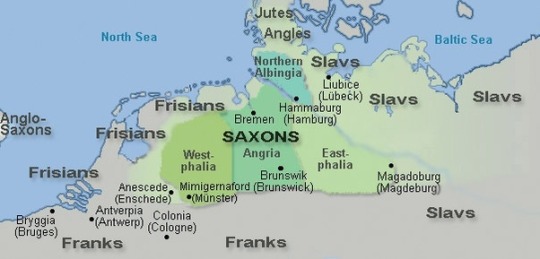
So let's discover the proper story.
In the early 400s, Saxon raiders left their lands in Germania and sailed to the east and south coasts of Britain, as well as to the North of France, as raiders. Because of this new pressure from the east, Roman infrastructure had reorganized itself to accommodate the threat, with all major power centers shifting eastwards. This happened internally in Armorica as well, with all military strongholds now facing the eastern border as well as the coast. A Roman military document, the Notitia Dignitatum, shows that the military command of Northern Gaul was totally removed from the interior and placed around the east and the coast to prevent Saxon landings at all costs. Few measures were taken to protect the west, which allowed the small-scale migration of Celtic Bretons to slip through.

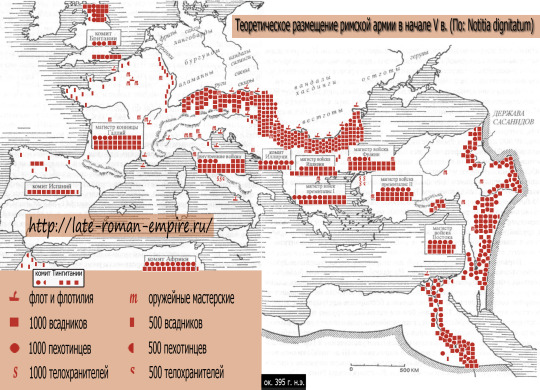
Roman cities such as Nantes, Vannes, and Rennes retained their Gallic language, Roman customs, and Roman affiliation, while the western lands of Armorica slowly filled with this new population which was closely tied to the British Celts. The name Armorica ("by the sea") fades out of use, and the first reference we have to "Brittany" is in a letter written by Sidonius Apollinaris. The people may have called themselves "Lidwiccias", and their land "Lledau" or "Letavia". A Breton tradition tells us that there was, for a time, a double kingdom existing on both sides of the English Channel, ruled by a single King Riwal of Gwent. He came from Eastern Wales and "ruled as 'dux Brittonum' on both sides of the sea until his death."
We have a number of saints' Lives (a biography of the saint) dating from the 9th century, while our earliest Welsh Lives come from the 11th. This, and the constant communication with Britain, indicates a generally high intellectual life in Brittany at the time. So it seems that the Dumnonii people of southwest Britain were not settling Brittany out of flight from invaders, but it was a political expansion encouraged by Irish raids into the Severn Sea. The Bretons expanded willingly into this newly unoccupied stretch of Armorica. As for the formation of a real Breton kingdom, our earliest sources refer to this peninsula called "Prettonaland" as a duchy or a realm, not a kingdom. Frankish sources especially emphasize the dependence of Prettonaland on the Frankish King Childebert.

And while the Franks were expanding their power over post-Roman Gaul under Clovis, the Armorican cities of Nantes, Rennes, etc. recognized the Franks as the rightful rulers of Armorica. The Bretons disagreed. The Franks saw themselves as heirs of Rome, and denied Breton freedom.

The Bretons nominally accepted the title of "Count" in the Frankish court, but this never hindered Breton independence struggles. As the Breton pushed eastward, the city of Vannes was transformed into the city of Bro Waroch ("Territory of Waroch"). Waroch was a lively figure in the accounts of Gregory of Tours, and a major rival of the Franks. In 587 he invaded Nantes, and in 588 he invaded Rennes and Nantes again. In 590 a powerful Frankish army tried to take Vannes, but it was destroyed by Waroch's son Canao. The struggle between Bro Waroch and Frankia lasted for centuries, with the Frankish armies being repeatedly wiped out by the Bretons, but the Bretons unable to hold onto what they had gained. Later, Louis the Pious appointed a native Breton named Nominoë as Count of Brittany, and the same Count then convinced King Charles the Bald to give Brittany independence. The Charles was occupied elsewhere with Viking invasions. With a later successor of Nominoë, named Salomon, Brittany paid tribute and homage to Charles the Bald once again, but within a few years, they had rebelled once more. However, after this failed rebellion, Brittany would enter the feudal world of medieval France. Not peacefully, not willingly, but the destiny of Brittany was forever tied to France. Here is what Arthur III of Brittany said about it in 1458:
I have always served Charles and his kingdom; I am constable, and as such I am bound to comply with the King's orders, but not as Duke of Brittany. I am not a peer of France, since my duchy has never been a part of the kingdom, and it is not a dismemberment of it; and, in order not to compromise the independence of my subjects, I will not appear in Montargis or elsewhere.
Fin

#brittany#celtic#history#france#french history#Britain#british history#bretons#rome#franks#gaul#druid#medieval#dark age#celt#europe#european history#french#emperor#kingdom#duchy#early medieval#Atlantic
21 notes
·
View notes
Text
"A historical chronological depiction from an imaginary Italy: a guess the reference game". 100th Anniversary
Unknown: Pdor Mythos Unknown: Appears the superheroes gene "Vip" 10'000 A.C: In the Mediterranean basin lives a society of amazoness 89 A.C: Marcus Aemilius Scaurus is born 71 A.C: Spartacus leads a slaves rebellion 55 A.C: Tros of Samothrace takes the parts of the Breton resistance against the Roman conquest of Britain 50 A.C: Julius Augustus Caesar's complete conquest of Gaul finds resistance against a village in Armorica 11 March 44 A.C: Julius Augustus Caesar is murdered 80: Barbarian Ardarico's conquest of Rome miserably fails; Flavian Amphitheatre is inaugurated and Timo becomes a gladiator 128: Architect Lucius Quintus Modestus repeatedly travels through time until the 21st century and visits the modern Japan 536: Martinus Paduei, a mysterious genius ahead of his time, leaves his mark in history as inventor, business owner, strategist and politician 569: King Alboin befriends and welcomes a sly and smart peasant to his court in Verona 726: Girolama Pellacani is raped by the Longobards 1050: Brancaleone of Norcia is born 1076: The saint hermit of Bismantova is sent to Aquileia in search of allies at the behest of Pope Gregory VII, but is hindered by the devil 1080: Brancaleone of Norcia takes part at the first crusade 1141: Baudolino is born 1150: Various supernatural events take place at the castle of Otranto 1249: The company of Selva Bella participates at the mission to free Enzo of Sardinia 1271: Marco Polo begins his travel toward the Orient 1280: Marco Polo reaches the court of Kublai Khan and tell him about the 55 cities 1295: Marco Polo returns to Venice Early XIV Century: To win the maritime war against Venice, the Genoese captain Luigi Gottardi builds the underground canal of Meloria 1300: Poet Dante Alighieri visits the afterlife in a week 1327: William of Baskerville is involved in a murder case sets in a benedictine abbey 15 April 1452: Leonardo da Vinci is born 1478: Takes places the quests of the "Company of the Gallows" 1506: Arte Spalletti becomes an artist 1534: Two english brothers find a passage for a subterranean world where the time flows more slowly and is populated by a society of pygmies 1537: During the battle of Turin a french soldier mysteriously survives to several deadly wounds 1570: To save her lover, war-prisoner at Famagosta in Cyprus, the duchess of Eboli wears an armor and under the alias of Captain Storm fights several battle against the Ottoman Empire 1595: The suicide of two lovers leads peace in a longtime feud between two Veronese families 1630: The black plague continues its killspread, Spanish local lord Don Rodrigo is found dead 1643: Nobleman Roberto de la Grive is presumed lost after a shipwreck in the Pacific Ocean 1650s: Alchemist Girolamo Fumagalli develops the basic technique of thanatography 1660s: Viscount Medardo of Terralba returns changed and maimed in a strange and impossible way from the Ottoman wars in Bohemia 1686: After losing his brothers during the Franco-Spanish war at the hand of Duke Wan Guld, the Lord of Ventimiglia Emilio of Roccabruna promises to avenge them and becomes the notorious Black Corsair 1711: A group of alchemists evoke a demon to gain eternal life 1713: Sir Frances Varney commits suicide by throwing himself into Mt. Vesuvius 7 January 1730: In Siena is approved the Notice of Violante of Bavaria 1741: Antonio Salvatore "Totò" Sapore invents pizza to bring peace between French and Neapolitan armies 1750s: Armando "The Scorpion" Catalano seeks the Templar treasure 1762: Reverend Yorick, friend of Tristram Shandy, visits France and Italy for a health issue 1764: Father Schedoni is involved in a conspiracy 1767: Cosimo Piovasco of Rondò, future baron of Ombrosa, climbs up a tree and will live his entire life on the trees 18 October 1775: Carlo Altovivi is born 1790: Scandal of the fallen noble family Mazzini 1798: Nobleman and soldier Fabrizio del Dongo is born 25 March 1799: Jacopo Ortis dies 1801: Vampire Giovanni Nosferatu is born 1812: Soldier Lazzaro Scacerni is one of the survivors of the retreat from Moscow and, after returning in Italy, becomes a wealthy miller 1825: History professor Mercurio Loi disappears 1826: Dr. Weiss solves the Fritzheim case 1829: A frenchman discovers the Spada family's treasure located in Montecristo Isle 1850: Count Isidor Ottavio Baldassarre Fosco reaches England to plan a political conspiracy 1855: Princess Teresa Uzeda of Francalanza dies 1860: The wooden puppet Pinocchio becomes a real children 1863: Three persons, claiming to be part of a scientific expedition, are spotted been ejected from Mt. Stromboli 1864: Countess Marina Vittoria Crusnelli of Malombra gets possessed 1870: Enrico Bottini is born; Edwin Drood mysteriously disappears leaving a secret still unsolved 1874: As social experiment some prisoners are released in a deserted island to create a self-managed isolated colony; Arsène Lupin is born 1878: Rosso Malpelo dies 1885: A frenchman from Tarascon survive to a fall during an attempt to reach the peak of Mt. Blanc 1887: Professor Sandrelli develops a substance that cancels gravity 1888: Full of remorse, baron Carlo Coriolano of Santafusca admits of being a killer 1889: Masked hero "Hidden Face" and Ugo Pastore take part at the Treaty of Wuchale; Escorted by english explorer Adam Wild, Count Narciso Molfetta explores Africa 7 December 1891: Vito Andolini is born 1893: Marco Pagot is born 1895: Architect Emilio Varelli starts the construction of the Three Mothers' manors September 1897: Giannino "Gian Burrasca" Stoppani is born 1898: The suppression of Milan riots are sabotaged by Tommaso Reiner 1899: Vadim Vadimovich N. Storov is born 29 May 1899: Giuseppe "Peppone" Bottazzi is born 30 May 1899: Don Camillo Tarocci is born Early 1900s: Paolo Zeder hypothesizes the "K-Zone" theory; Actress Maria Sarti gains notoriety under the stage name Ninì Tirabusciò 1910: Architect Emilio Varelli finishes the construction of the Three Mothers' manors; Aldovino reaches the moon to marry the princess Yala; Count Emilio Ponticelli partecipes at the Daily Post air race 1911: Famous composer Gustav von Aschenbach dies during a holiday in Venice WWI: Flying ace Marco Pagot turns into an anthropomorphic pig and assumes the identity of the bounty hunter Porco Rosso; Aviator Luciano Serra, aviator Matteo Campini, Private Lazzaro Scacerni and Private Italino take part at the conflict; Baron Cesare Stromboli helps the Triple Entente; Private Piero dies 1915: Air piratess Filibus terrorizes southern Italy performing several thefts 15 October 1915: Emilio Largo is born 1919: A man dressed in red and constantly speaking in rhyme becomes one of the richest italian 1920: Famous film director Guido Anselmi is born; Pugilist Furio Almirante emigrates in America 1927: Dr. Artemio Zacchia founds a medicine and natural science academy and starts his studies on immortality March 1927: Detective Francesco "Ciccio" Ingravallo solves the Via Merulana mystery June 1929: Fascist militia suppression at Fontamara 1930: Dominetta Vitali is born; Scientist Pier Cloruro de' Lambicchi creates a substance that gives life to the images 1933: Gastone Uliani investigates the faun's case 17 July 1934: Ugo Fantozzi is born 1935: Italy's invasion of Ethiopia is obstacled by local spy Bara 1936: Lawyer Gino Motta is locked up in an asylum after claiming that in the sea near Levanto lives a colony of mermaids 29 September 1936: Lolito B. Lassica is born 1938: Benzino Napaloni signs an alliance with Adenoid Hynkel; The launch of hierarch Gaetano Maria Barbagli's expedition for Mars takes place; Primo Cossi chooses to undergoes at the EPRA experiment; Dr. Emilio Lizardo and Professor Tohichi Hikita build the oscillation overthruster, Lizardo trying to enter into the 8th dimension becomes insane; American archeologist Martin Padway travels through time until 535 1939: Count Zero becomes a fascist agent; Film director Salvatore Di Vita is born 10 May 1939: Hierarch Gaetano Maria Barbagli and his troop land on Mars WWII: Captain Alberto Bertorelli, Captain Antonio Corelli, Major Oscar Pilli, Sergeant Nicola Lo Russo, Lieutenant Gino Rossati, Marmittone and Galeazzo Musolesi take part at the conflict; Partisian Johnny loses his life; Partisan Natalino "Capellone" Tartufato saves the life of the english spy Charles Harrison, Private Antonio is considered as straggler in Russia 1940s: Marcella Valmarin becomes a famous actress under the stage name of Alba Doris 25 December 1942: Photographer Valentina Rosselli is born 1943: The Finzi-Continis family is exterminated in a German Nazi lager, along with other jews 1944: In a hidden palace in the Republic of Salò, tortures takes place by hand of four wealthy personality of the republic 1945: End of World War II in Europe and the prison camps are freed, Giosuè Orefice is among the survivors 3 March 1945: Nicola "Nico" Giraldi is born 6 July 1945: Roberto "Rocky" Balboa is born 1950s: Bianca Castafiore is recognized as one of the best soprano in the world; Amelia Bonetti and Pippo Botticella become two renowned tip-tap dancers 6 September 1950: Salvo Montalbano is born 1952: In a laboratory comes to life a creature made of rubber 1953: Michele Apicella is born; During a diplomatic visit in Italy a princess escapes through the streets of Rome 1955: Criminal and con artist Mr. Ripley lands in Italy 1956: Painter Buono Legnani commits suicide 1957: Exorcist Don Zauker lands in Livorno 19 September 1958: Renato "René" Ferretti is born 1959: Topo Gigio debuts and becomes a television star; Detective Nero Wolfe moves to Rome after some "problems" with FBI 1960: Authoress Enrica Valldolit wins the Nobel Prize in Literature 1961: A british spy agent kills the terrorist Emilio Largo; A cemetery man has a close encounter with the Death 15 August 1962: A young university student loses his life in a car accident caused by an overtaking 1963: Medic Duca Lamberti loses his license and is imprisoned for practicing euthanasia; Calimero is born; "The Alphabet Killer" is caught 1966: Criminal Mastermind "The Fox" evades from prison 4 October 1967: Deboroh La Roccia is born 1968: Diabolik is presumed dead; Primo Cossi wakes up from hibernation and becomes a hitman related to the events of the Years of Lead 1969: A british criminal gang robs the FIAT industry 1970s: A criminal uses the sewer of a metropolis as hiding place and house; At Milan a group of bounty hunters form the C.T Association 1971: Fumagalli's thanatography is used to solve the four flies' mystery; Alberto Valle becomes the new Avio Motor CEO 1972: Somewhere in northern Italy, inside the Military Area 36, Professor Endriadi and his research team build the first AI February 1973: Four men commits suicide through planteration in a villa near Paris 1 June 1973: A terroristic attack blows up the Madonnina statue atop Milan Cathedral 1974: Andrea Straniero is born; Approved the healthcare reform "C.M.G"; Camilla Cagliostri is born 1975: After months of shipwreck on a deserted island in the Mediterranean sea, the wife of the industrial Lanzetti and a sailor are saved; The corpses of the Crespi d'Adda cemetery are resurrected; At Rome, German psychic medium Helga Ulmann is brutally killed 1976: For having inflicts severe damages to the organized criminality all over Italy in just few years, mysterious killers murder the police commissioner Betti 1977: Virginia Ducci survives at a murder attempt thanks to her clairvoyance 1978: Science fiction writer Della Spigola is abducted by the martians of Phobos; Discovered a breed of talking dog with a particular white fur with red spots; Famous chef Fausto Zoppi is killed by drowning; It ends the Filippo Carducci's kidnapping case; Riccardo Finzi begins his career as P.I 1979: 1980s: The ministry of the Great Hunt is founded; 1980: "Caterina" an American brand of robotic housekeeper goes on sale; Neapolitan camorra boss "The Marseillaise" and his gang are killed after a showdown; Rocky Giraldi is born, so named in honour of the famous boxer 12 August 1980: The Matchstick Man is spotted near the Abruzzi countryside 3 October 1980: Leonardo Zuliani is born 1981: The criminal known as "The Human Beast" loses his life in a gunfight 1982: The "K-Zone" theory is confirmed and Paolo Zeder is resurrected as zombie 1983: For the first time, alive people witness the "Palio di Siena of the dead contrade"; It is archived the case of the serial killer known as "The Killer Dwarf"; Naples F.C pays three billion for the acquisition of Brazilian footballer Paulo Roberto Cotequinho, he'll lead the Naples to the victory of its first championship four years later. 1984: Two men inadvertently travel through time back the 1492 August 1988: The first issue of "Bloody Eye" is published 1989: During a conference in Rome, experts try to discover the truth behind the Edwin Drood mystery; Deboroh La Roccia becomes Rat-Man 20 March 1989: Commissioner Corrado Cattani is killed in a mafia ambush 1990: FIFA World Cup scandal, the Italy team hires two pornstars to win; Salvo Montalbano becomes a police commissioner 1991: 1992: Sicilian gangster Johnny Stecchino uselessly resort to a person exchange to avoid death; During the annual Milan Film Festival, mystery fiction writer and amateur sleuth Jessica Fletcher resolves a murder case; During the quadrennial pallastrada world competition the St. Catherine prophecy comes true burning up the entire state of Gladonia November 1992: Daria Marchesi is jailed for the Baldacci murder, thus Marino Strano becomes Bloody Eye's head writer 1994: "The Florence Monster" is finally arrested; A feud between two families ends with the use of a low-potential atomic warhead; After various vicissitudes experienced in India, Marco Donati is exposed at the Aquarium Berlin as "The boy with the gills" 1995: Marco Buratti aka "The Alligator" starts a new career as P.I. 1996: After his death Ugo Fantozzi returns to life until 1998 1997: Police agent Napoleone di Carlo abandons his profession and moves in Switzerland 1999: Ugo Fantozzi is cloned; "The Fish in Love" becomes an international bestseller 2000s: Jimi Dini works at the development of his videogame "Nirvana"; Dr. Bartolomeo Zacchia continues his father's studies 2001: A romanian vampire is sighted in Rome April 2001: Giorno Giovanna becomes the Gangstar of the mafia association "Passione" 2005: Police agent Rocky Giraldi enters in service 2006: Rise of nationalism in Italy brings to the birth of Captain Padania July 2006: Activist Leonardo Zuliani disappears 2007: Mater Lacrimarum is killed 2009: During a spiritual séance, Gualtiero Marchesi conjures the Emily Ann Faulkner's spirit 2013: Long Wei becomes a local hero for the chinese communities in Italy; Celestine VI becomes the new pope 2014: An amateur gang of smart drugs dealers is arrested; Michele Silenzi gains superpowers 2015: Low-grade criminal Enzo Ceccotti gets superpowers and becomes the superhero Jeeg Robot; Arsène Lupin's grandson is spotted in Italy 2016: Benzino Napaloni is cloned; Intellectual Mario Bambea survives at his suicide attempt, contemporaneously begins the rise of popularity of the comedian Fabrizio "Bizio" Capoccetti 2017: In Calabria a farmer befriends a rare specimen of unicorn 11 September 2077: An asteroid falls in northeast Italy sweeping away Padoa, Vicenza and Verona while Venice is half submerged
|Cities&Places| The Seven Cities Meloria Canal Gualdana Pine Forest Nepente Isle Stranalandia Island Desolation Isle Pescespada Island Malapunta Clerville Porcionia Bacteria Kindaor Gladonia Tristalia The Land of Toys Gerolstein Lotto Valentino Bassavilla Lancimago Vigata Montelusa Loquasto The 55 Invisible Cities Pratofungo Ombrosa Pineta Sagunto Pista Prima Frittole Sevalio Brigantes Sompazzo Monzurlo Salsiccia Acqua Traverse Buffalora Roccaverdina Nofi Norbio Solara Scasazza Ponteratto Idrasca Giancaldo Pieve Lunga San Michele Borgo Tre Case Borgo Dieci Case Accendura
|Fiction in Fiction| Urban X (Pope) Astrubal I (Pope) Pius XIII (Pope) Celestine VI (Pope) Luke I (Pope) Libero I (Pope) Teomondo Scròfalo (Painter) Dùdron (Painter) Amos Pelicorti (Sculptor) Jep Gambardella (Writer) Cornelio Bizzarro (Writer) Leo Cordio (Writer) Ulisse Isolani (Writer) Ubaldo Terzani (Writer) Vincenzo de Fabritiis (Writer) Thomas Prostata (Writer) Giovanni Pontano (Writer) Giuseppe Marchi (Writer) Morgan Perdinka (Writer) Antonio Casella (Writer) Enrico Puzzo (Writer) Arturo Vannino (Writer) Edoardo Lasagnetta (Writer) Ugo Redy (Writer) Carlo Sperato (Poet) Giancarlo Santini (Film Director) Lippini Bros (Film Directors) Gambalesta (Actor) Enzo Melchiorri (Actor) Franco Melis (Actor) Saverio Crispo (Actor) Marco Salviati (Actor) Sofia Barlow (Actress) Giorgio Fini (Tenor) Carlo "Vitalis" Balzani (Tenor) Tony Corallo (Singer) Pat Rubino (Singer) Luca Pappacena (Singer) Quartetto Basileus (Band) Martino Piccione (Guitarist) Mariottide (Songwriter) DJ Vomito (Rapper) Bud "Bomber" Graziano (Boxer) Franco Fibbri (Soccer Player) Antonio Pisapia (Soccer Player) Gli occhi del cuore ("The Eyes of the Heart") (Tv Series) Medical Dimension (Tv Series) La Bomba ("The Bomb") (Tv Series) Redenzione ("Redemption") (Movie) Paura d'odiare ("Fear to Hate") (Movie) L'usuraio licantropo ("The Werewolf Usurer") (Movie) Thor e le regine nude ("Thor and the Naked Queens") (Movie) Il vortice equestre ("The Equestrian Vortex") (Movie) La regina del pianeta nero ("The Queen of the Black Planet") (Movie) La palude del caimano ("The Caiman Marsh") (Movie) La vendetta del cobra ("Cobra's Revenge") (Movie) I ragazzi del Bronx ("The Bronx Boys") (Movie) Il caimano ("The Caiman") (Movie) Cataratte ("Cataracts") (Movie) Mocassini assassini ("Assassin Moccasins") (Movie) Maciste contro Freud (Maciste Versus Freud") (Movie) La mamma di Freud ("Freud's Mom") (Movie) Natale con la casta ("Christmas with the Caste") (Movie) La Febbra ("The Fever") (Movie) La polizia s'incazza (Movie) Sinite Parvulos (Movie) Margas (Movie) Il terrore di Parigi ("The Terror of Paris") (Play) Space Queen Vega (Videogame) Amedeo's Revenge (Videogame) Il codice indecifrabile ("The Indecipherable Code") (Novel) L'albicocco al curaro ("Apricot with Curare") (Novel) La paura del giorno ("Fear of the Day") (Novel) L'apparato umano ("The Human Apparatus") (Novel) Evoluzione digitale ("Digital Evolution") (Novel) Cortocircuito ("Short Circuit") (Novel) Folgore su Policastro ("Thunderbolt over Policastro") (Novel) La ninfa e il cadetto ("The Ninphe and the Cadet") (Novel) Il pesce innamorato ("The Fish in Love") (Children's Book) Bloody Mario (Comic Strip) Bloody Eye (Comic Book) Megaditta (Company) Nosferatù (Company) Finmor (Company) Centovetrine (Company) Auto Avio Motor (Company) SOFRAM (Company) Tekne (Company) Wondercomics (Company) Tondello Spa (Company) Digitex (Company) Sbav (Company) Famburgher House (Company) Trattoria Aldini (Company) Smack-O-Mat Corporation (Company) Partito Regressista (Politic) Partito Socialista Unificando (Politic) Italia in Marcia (Politic) Grande Destra (Politic) Longobarda (Football Club) Borgorosso (Football Club) Marchigiana (Football Club) Olimpia (Football Club) Eat it! (Product) Fido Uomo (Product) Io Cane (Product) Pandoro Sauli (Product) Cacao Meravigliao (Product) Cioccolato Spagnoli (Product) Marmellata Puffin (Product) Acqua pulita (Product) Coralba (Product) Sarchiapone (Animal) Colombre (Animal) Jaguar Shark (Animal) Tropelio (Animal)
17 notes
·
View notes
Text
Film Grammar for Simmers
What is film grammar?
"Film grammar" refers the unstated "rules" of editing used in movies and TV. Different types of shots have different associations and are used by editors to convey different types of information to the audience. Many of these principles were first described in the early 20th century by Soviet directors, but they're used consistently across genre, medium, and even language: Bollywood musicals, English period dramas, Korean horror movies, and American action blockbusters all use many of the same techniques.
Because these rules are so universal, virtually everyone has some internalized understanding of them. Even if they can’t name the different types of shots or explain how editors use images to construct meaning, the average person can tell when the “rules” are being broken. If you’ve ever thought a movie or episode of TV was confusing without being able to say why, there’s a good chance that there was something off with the editing.
Learning and applying the basics of film grammar can give your story a slicker and more-polished feel, without having to download shaders or spend hours in photoshop. It also has the bonus of enhancing readability by allowing your audience to use their knowledge of film and TV to understand what's happening in your story. You can use it to call attention to significant plot details and avoid introducing confusion through unclear visual language.
Best of all, it doesn't cost a dime.
The basics: types of shots
Shots are the basic building block of film. In Sims storytelling, a single shot is analogous to a single screenshot. In film, different types of shots are distinguished by the position of the camera relative to the subject. There are three big categories of shots, with some variation: long shots (LS), medium shots (MS), and close-ups (CU). This diagram, created by Daniel Chandler and hosted on visual-memory.co.uk illustrates the difference:
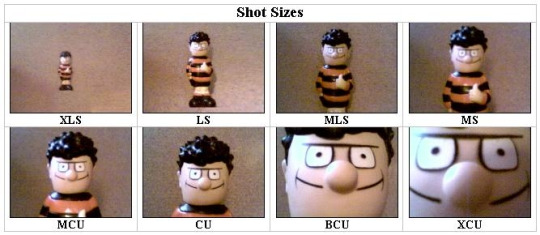
Source: The 'Grammar' of Television and Film, Daniel Chandler, visual-memory.co.uk. Link.
In film, scenes typically progress through the different types of shots in sequence: long shot, medium shot, close-up. When a new scene begins and the characters arrive in a new location, we typically begin with a wide establishing shot of the building’s exterior to show the audience where the scene will be taking place. Next comes a long shot of an interior space, which tells the where the characters are positioned relative to one another. The next shot is a medium shot of the characters conversing, and then finally, a close-up as the conversation reaches its emotional or informational climax. Insert shots are used judiciously throughout to establish themes or offer visual exposition.
Here's another visual guide to the different types of shots, illustrated with stills from Disney animated films.
This guide is almost 2,000 words long! To save your dash, I've put the meat of it under the cut.
Long shot and extreme long shots
A long shot (sometimes also called a wide shot) is one where the entire subject (usually a building, person, or group of people) is visible within the frame. The camera is positioned far away from the subject, prioritizing the details of the background over the details of the subject.
One of the most common uses of long shots and extreme long shots are establishing shots. An establishing shot is the first shot in a scene, and it sets the tone for the scene and is intended to give the viewer the information they’ll need to follow the scene: where a scene is taking place, who is in the scene, and where they are positioned in relation to one another. Without an establishing shot, a scene can feel ungrounded or “floaty.” Readers will have a harder time understanding what’s happening in the scene because on some level, they’ll be trying to puzzle out the answers to the who and where questions, distracting them from the most important questions: what is happening and why?
(I actually like to start my scenes with two establishing shots: an environmental shot focusing on the scenery, and then a second shot that establishes the characters and their position within the space.)
Long shots and extreme long shots have other uses, as well. Because the subject is small relative to their surroundings, they have an impersonal effect which can be used for comedy or tragedy.
In Fargo (1996) uses an extreme long shot to visually illustrate the main character’s sense of defeat after failing to secure funding for a business deal.The shot begins with a car in an empty parking lot, and then we see the protagonist make his way up from the bottom of the frame. He is alone in the shot, he is small, and the camera is positioned above him, looking down from a god-like perspective. All of these factors work together to convey his emotional state: he’s small, he’s alone, and in this moment, we are literally looking down on him. This shot effectively conveys how powerless he feels without any dialogue or even showing his face.
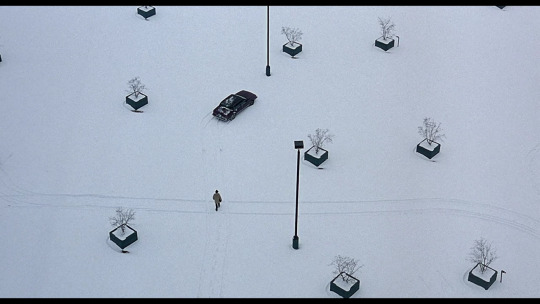
The same impersonal effect can also be used for comic purposes. If a character says something stupid or fails to impress other characters, cutting directly from a close-up to a long shot has a visual effect akin to chirping crickets. In this instance, a long shot serves as a visual “wait, what?” and invites the audience to laugh at the character rather than with them.
Medium Shots
Medium shots are “neutral” in filmmaking. Long shots and close-ups convey special meaning in their choice to focus on either the subject or the background, but a medium shot is balanced, giving equal focus to the character and their surroundings. In a medium shot, the character takes up 50% of the frame. They’re typically depicted from the waist-up and the audience can see both their face and hands, allowing the audience to see the character's facial expression and read their body-language, both important for interpreting meaning.
In most movies and TV shows, medium shots are the bread and butter of dialogue-heavy scenes, with close-ups, long shots, and inserts used for punctuation and emphasis. If you’re closely following the conventions of filmmaking, most of your dialogue scenes will be medium shots following the convention of shot-reverse shot:
youtube
To keep long conversations from feeling too visually monotonous, consider staging the scene as a walk-and-talk. Having two characters move through a space can add a lot of dynamism and visual interest to a scene that might otherwise feel boring or stiff.
Close Ups
Close-ups are close shots of a character’s face. The camera is positioned relatively near to the subject, showing just their head and shoulders. In a close-up, we don’t see any details of the background or the expressions of other characters.
In film, close-ups are used for emphasis. If a character is experiencing a strong emotion or delivering an important line of dialogue, a close-up underscores the importance of the moment by inviting the audience to focus only on the character and their emotion.
Close-ups don’t necessarily need to focus on the speaker. If the important thing about a line of dialogue is another character’s reaction to it, a close-up of the reaction is more effective than a close-up of the delivery.
One of the most iconic shots in Parasite (2019) is of the protagonist driving his employer around while she sits in the backseat, speaking on the phone. Even though she’s the one speaking, the details of her conversation matter less than the protagonist’s reaction to it. While she chatters obliviously in the background, we focus on the protagonist’s disgruntled, resentful response to her thoughtless words and behavior.

In my opinion, Simblr really overuses close-ups in dialogue. A lot of conversation scenes are framed entirely in close-ups, which has the same effect of highlighting an entire page in a textbook. The reader can’t actually tell what information is important, because the visuals are screaming that everything is important. Overusing close-ups also cuts the viewer off from the character’s body language and prevents them from learning anything about the character via their surroundings.
For example, a scene set in someone’s bedroom is a great opportunity for some subtle characterization—is it tidy or messy? what kind of decor have they chosen? do they have a gaming computer, a guitar, an overflowing bookshelf?—but if the author chooses to use only close-ups, we lose out on a chance to get to know the character via indirect means.
Inserts
An insert shot is when a shot of something other than a character’s face is inserted into a scene. Often, inserts are close-ups of a character’s hands or an object in the background. Insert shots can also be used to show us what a character is looking at or focusing on.
In rom-com The Prince & Me (2004) (see? I don’t just watch crime dramas…) the male lead is in an important meeting. We see him pick up a pen, look down at the papers in front of him, and apparently begin taking notes, but then we cut to an insert shot of his information packet. He’s doodling pictures of sports cars and is entirely disengaged from the conversation. Every other shot in the scene is an establishing shot or a medium shot or a close-up of someone speaking, but this insert gives us insight into the lead’s state of mind: he doesn’t want to be there and he isn’t paying attention.

Insert shots are, in my opinion, also used ineffectively on Simblr. A good insert gives us extra insight into what a character is thinking or focusing on, but a poorly-used insert feels…unfocused. A good insert might focus on pill bottles on a character’s desk to suggest a chemical dependency, on a family picture to suggest duty and loyalty, on a clock to suggest a time constraint, on a pile of dirty laundry or unanswered letters to suggest a character is struggling to keep up with their responsibilities. An ineffective insert shot might focus on the flowers in the background because they’re pretty, on a character’s hands because it seems artsy, on the place settings on a dining table because you spent forever placing each one individually and you’ll be damned if they don’t make it into the scene. These things might be lovely and they might break up a monotonous conversation and they might represent a lot of time and effort, but if they don’t contribute any meaning to a scene, consider cutting or repurposing them.
I want to emphasize: insert shots aren’t bad, but they should be carefully chosen to ensure they’re enhancing the meaning of the scene. Haphazard insert shots are distracting and can interfere with your reader’s ability to understand what is happening and why.
Putting it all together
One of the most basic principles of film theory is the Kuleshov effect, the idea that meaning in film comes from the interaction of two shots in sequence, and not from any single shot by itself. In the prototypical example, cutting from a close-up of a person’s neutral expression to a bowl of soup, children playing, or soldiers in a field suggests hunger, worry, or fear, respectively.
youtube
The Kuleshov effect is the essence of visual storytelling in a medium like Simblr. You can elevate your storytelling by thinking not only about each individual shot, but about the way they’ll interact and flow into one another.
Mastering the basics of film grammar is a great (free!) way to take your storytelling to the next level. To learn more, you can find tons of guides and explainers about film grammar for free online, and your local library doubtless has books that explain the same principles and offers additional analysis.
Happy simming!
#armorica tips#armorica ooc#i finally got off my ass to finish this guide which i started back in August right before I got extremely sick and ended up in the hospital#anyway....hope you enjoyed this post which was a veiled excuse for me to complain about how people overuse close-ups and inserts#and i can't tell what's happening in their stories ;fdsklsjadf;laksdf#Youtube
348 notes
·
View notes
Text
Written guide for people who don't want to waste six minutes sitting through a video tutorial that doesn't even tell you where to find the file you're modifying:
Locate the VideoCamera file. On PC, this is in C:\Program Files (x86)\Origin Games\The Sims 4\Game\Bin\res and on Mac this is in The Sims 4.app > Contents > Resources > res (source: Simp 4 Sims)
Save a backup copy of the unaltered VideoCamera file.
Modify the values for MaxMoveSpeed and MaxVericalMoveSpeed. The default value for these is 200.0, in the video, she suggests changing them both to 10.0.
If desired, also change the Deceleration value to 0.0 to prevent camera "float." (default value is 0.02).
Save and close the VideoCamera file.
To revert the changes, either modify the file again to restore the default numbers or drag the unmodified backup back into the Bin/res folder.
OMG Y'ALL!!!!
So I usually never have this problem because, up until a few weeks ago, all my mains were living in either one or two level homes. Well, now that one is in a 4th floor apartment and his parents having a master bedroom on the 3rd floor of a townhome, I've been dealing with super speed camera again.
What is super speed camera? Its where, when you're in tab mode and the camera speed gets faster the higher up you go or the further out you go. Its hard to explain, and y'all may have already figured this out by now, but I haven't...
UNTIL NOW!
youtube
Shout out to this person who, with just showing how to change a few numbers, saved me a horrible horrible headache.
Might be useful to you.
#armorica tips#queue#remember how you used to be able to google a tutorial and find a thing you could read and follow along with at your own pace#and easily refer back to previous steps if you missed something instead of having to scrub through a video repeatedly to find what you need#those were the good old days
799 notes
·
View notes
Text
fashion and world-building for royal simblr
my friends are sick and tired of listening to me ranting and raving about how fashion can be used to convey information about your characters and setting. instead, i bring my rants to you, the general public.
disclaimer that I'm (obviously) not mandating that everyone have an answer to every single one of these questions or that your story is bad if you don't think this much about your sims' wardrobes. my own personal answer to half of these questions is "I dunno, I never thought about it" and/or "I dunno, I'm not interested in that"
don't treat this list like homework, consider it a series of suggestions and prompts that might spark something interesting for your story :)
Does your royal family have a dress code? Are there codified internal rules for how your royals are expected to dress, or is it an unspoken set of expectations?
If your royals have a dress code, who sets it? How is it enforced? Does it ever change?
Are any of your royals considered style icons? What impact does their wardrobe have on trends within your country?
Are your royals expected to dress modestly? How do they define 'modest?'
Do your royals wear trendy clothes or are they expected to dress conservatively or in an old-fashioned way?
Are your royals allowed to be experimental or "alt" in the way they dress?
Are your royals expected to dress in a gender-conforming way?
How much autonomy do your royals have in deciding what to wear?
How do your royals pay for their wardrobes? If their clothes are paid for with public money, how does the general public feel about that?
Do your royals have their clothes custom-made? Do they wear designer clothes? Do they shop at normal stores and wear "accessible" brands?
How do your royals use clothes to signal class status? Do they practice conspicuous consumption, or do they dress in an understated way to signal that they're above wealth?
Do your royals have relationships with the designers of their clothes? Do they have any favorites? Do they borrow clothes from designers? Attend fashion shows? Accept "freebies?"
Do your royals ever re-wear outfits? Is this normal for them, or do re-wears drive commentary? What do they do with all the clothes they'll never re-wear?
How much jewelry does your royal family own? When do they wear it? Are there any rules (formal or informal) about colored stones?
Are there any non-jewelry garments that have been passed down by the royal family? (i.e., a bridal veil, a Christening gown)
Does your country have folk costumes or traditional dress? Who wears traditional clothes and on what occasions?
What kinds of textiles are produced in your country?
How do royal children dress? Are there any clothing that children have to "graduate" into? (for example: British princes have traditionally worn shorts and knee socks during official appearances until they're 9 or 10, when they begin wearing longer pants.)
Are there any differences between how your royals dress while on duty and how they dress in their private lives?
What do your royals wear for special occasions like weddings and funerals?
What kinds of political messages do your royals send through their clothes? Are they expected to wear clothes from designers from their own country? When they travel overseas, do they wear designers from their host country?
Clothes and fashion are a huge part of how royals are understood and interpreted, historically and in the present. It's almost impossible to discuss the French Revolution without touching on Marie Antoinette's wigs and gowns. On the opposite end of the spectrum, modern royal women often wear a mix of expensive and affordable pieces in order to be seen as relatable to the average woman and because they know what happened to Marie Antoinette.
So go forth! Incorporate fashion into your story! Make worldbuilding posts with all the lore! Write up individual histories of your royals' fashion evolutions! Do all of this and then tag me so I can read it 😤
47 notes
·
View notes
Text
PSA: If you are sharing CC via google drive, your full name may be visible
If you share your CC or sims via Google drive, do so on a secondary account without your legal name attached.
You do NOT want every internet rando to know your wallet name. You do not NOT want every internet rando to be able to google you and find: your place of work, the place you live, the names of your friends and family. Most people will not do anything malicious with this information, even if they realize they have access to it, but there are people out there who may use this information to harm you.
I'm not talking about someone finding your home address and showing up with a camera (although that has happened recently). I'm talking about people googling your name, figuring out where you work, and yelp-bombing to try to get you fired. I'm talking about people contacting your school, your parents, your landlord.
Protect your privacy. Do not leave the door open for weirdos to try to wreck your life over fandom drama. Do not use professional or real name accounts for fandom stuff.
161 notes
·
View notes
Text
how i (try to) make my text readable
so as a lifelong glasses wearer north of 25, i cannot see shit! I love the look of text on screenshots, but also i have spent a nonzero amount of time squinting at pale text on a busy background and thought "i cannot fucking read that."
there are lots of ways to do this. my method is not perfect. I am constantly tweaking things to try and make the text more readable. if you have suggestions about making the text more readable, please share!
Step One: Open the screenshot in your photo editor
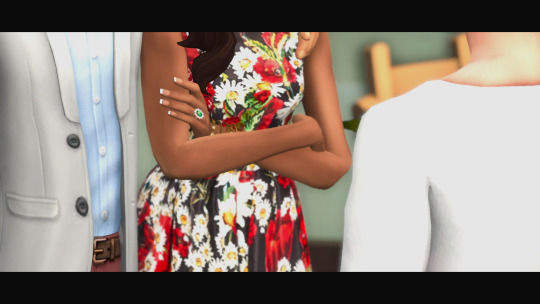
I start with a screenshot and a script. I use Gimp, a free and open-source photo editor, and I pretty much only use it to put captions on my screenshots, so please do not ask me how to actually edit pictures, I do not know. also, please do not ask me how to do this in any photo editor, i prefer to use this one because it is free, ad-free one that I can own legally and download safely.
open-source software RULES, btw.
Step One: Add a text layer with your dialogue

I use the text tool to add the dialogue to the image, copying and pasting from my script. This is not legible. My eyes hurt. I cannot read that, so I can't tell if I've made any typos.
Step Two: Add a black background to the text.
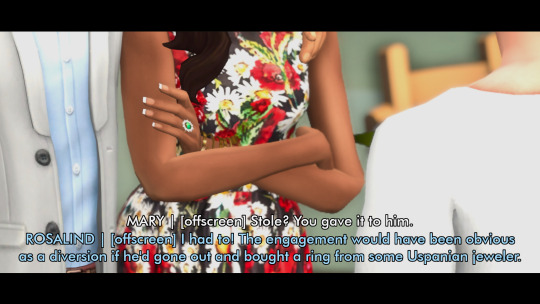
In, Gimp: Right click text layer > "Alpha to Selection." In the top menu, Selection > Grow > 3 pixels. Top menu: Layer > New Layer. (I name the new layer "Text BG ##") Use the bucket tool to fill the selection on the new later.
There's probably a shortcut to doing this in other photo editors (hell, might be a shortcut in Gimp.)
Step Three: Blur the background

In Gimp: Top Menu > Effect > Blur > Gaussian Blur. This may be a step backward in terms of readability, but I like how it looks. Let's try a few other things to help the reader, shall we?
Step Four: Drop Shadow
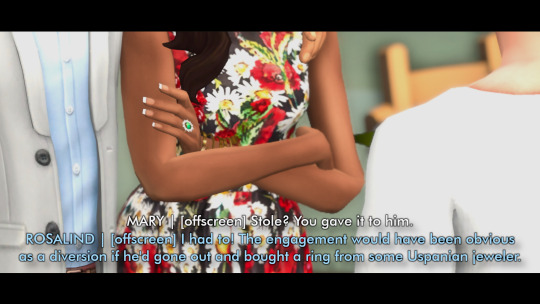
In Gimp: Top Menu > Light & Shadow > Drop Shadow. Makes the text stand out a bit more. Still not particularly readable, especially the blue on blue on the left side of the image.
Step Five: Gradient layer
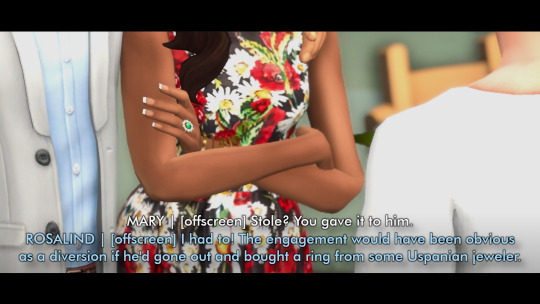
Create a new layer underneath the Text BG, and then add a transparent gradient over the entire image.
This is step is slightly more involved, so I'll just link you to a guide instead of explaining myself: "How to create a gradient transparency in GIMP."
Step Six: Further Tweaks

I still wasn't satisfied with the readability of the text. I duplicated the gradient layer to create a darker background underneath the text. I also repeated the drop shadow step on the Text BG layer. You could also make the text larger or bolder, change font colors, grow the selection by 4 or 5 pixels instead of 3, or skip the blurring step. I change my method frequently to try to get the best look for each individual image, and I don't always do a perfect job.
This is an area where I constantly innovate. I want people to be able to actually read my text, so I try not to let myself be satisfied with "good enough." When I take screenshots, I try to do it with an eye for compositions that give me a nice, blank space on the bottom for text, ex.
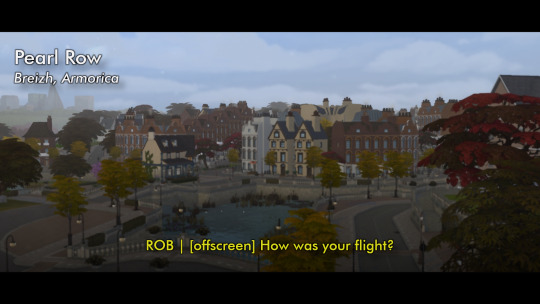


132 notes
·
View notes
Text
How I organize my files:
Every time this subject comes up, people are like ??? so here's a quick explanation of how I do things
One folder per chapter, one subfolder per scene

I have a folder on my desktop where I dump all of my story-related files (screenshots, edits, WIPS, personal recolors), and every chapter/arc of my story has its own folder. Within that folder, I create a sub-folder for every scene.
Each folder is numbered and named with each of the major characters who appear in that scene. If there are scenes with the same characters, I number them. This helps with pacing and planning arcs within chapters, because I can see when characters appear and reappear and look for other patterns.
When I finish a scene, I rename the folder to add DONE. This is for the ease of tracking my progress and figuring out what I still need to work on. This is especially helpful if I decide to skip around and work out of order, as I did on this chapter!
Within each subfolder, numbered screenshots

I dump all the screenshots for a particular scene into my scene folder, and as I sort through and decide which screenshots to use in what order. I number the screenshots as I go, and I move the unused screenshot into the "not in use" folder.
000_letterbox is a template file I use that has my format and colors for captions, along with some other reference stuff saved. I copy the template folder into the scene subfolder, and then use it to begin editing the screenshots for each scene.

When I finish editing a screenshot, I export it and add a c for captioned to each screenshot name. That way, all the raw screenshots are in order, and all of the completed, edited screenshots are also in order, separate from the raw images.
Finished chapters go in the archive
When I finish a chapter, I copy any screenshots I especially like into a separate reference folder, delete the "not in use" folders to save disk space, and then I use 7-zip to compress each chapter into a zipped folder. I move the zipped folder into a portable drive and then delete the original unzipped chapter files off my computer.
Why I do this
I'm just like that. But also, it makes sure that my things are organized and I can easily find the original, raw file for a particular screenshot if I ever need to use it for anything.
There's not really a single best way to organize your files, but I think it's a good idea to come up with some kind of method. You don't need to go back and organize old stuff (unless you want to!) but it's nice to have a simple system to help you find stuff on your computer.
This is a transferable skill btw, if you end up with an office job and you're good at file management and can easily find stuff, people will think you're a genius.
#armorica tips#dont ask to see how i organize my mods folder because the answer is I don't#PVP enabled zone in there
12 notes
·
View notes
Text
beautiful and horny
I recently reread one of my favorite essays, Everyone is Beautiful and No One is Horny, and posted a bit about it here. The difference between "beautiful" and "horny" (between "hot" and "sexy," as my bestie @nexility-sims puts it) is kind of difficult to explain in the abstract. So instead of just complaining, I thought it might be useful for me to try to explain how I've tried to depict sex and desire in my story.
Suggestion One: use close-ups to demonstrate desire
First off: I think the key to making something sexy isn't to show someone or something that is visually beautiful. Sexiness isn't about aesthetics, it's about desire. It's very easy to show the audience a beautiful person, harder to make clear that they are desirable. Desire isn't about seeing a beautiful person, it's about looking at them and noticing things about them, specific things. Desire often carries a little bit of objectification with it, and that's okay -- the problem is when someone is wholly objectified, made into a passive thing, a receptacle for desire rather than a person who is themselves desirable.
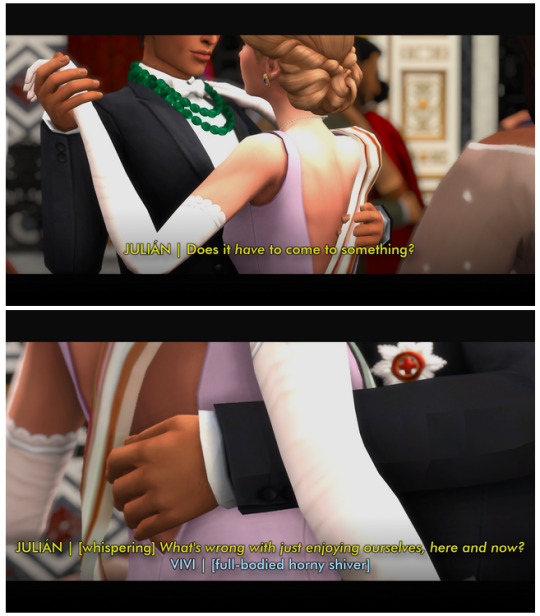
In this scene, I have two close-ups that emphasize Vivi's backless dress (and Julián's touch). She's wearing that backless dress the whole time, but we don't really notice it until the camera calls specific attention to it by moving in close. The zoom-in on the second shot intensifies what is already present in the first shot, creating a sense of escalation -- it's the same thing, twice in a row, but there is a sense that tension is building. Please also note that Julián is bare-handed, but all the Armoricans are all wearing gloves.
So, to show that someone is desirable, you need to show what the other character is noticing about them. This is happily pretty easy in a visual medium! The entire point of a close-up is to show the audience what they're meant to be noticing: the listening device hidden in the potted plant, the smudged handwriting in a suspect's passport, the curve of the love interest's spine in her backless dress. An effective close-up helps the reader see the character as their love interest does, helps them understand why that character is sexy.
(This doesn't need to be entirely physical! Skill and expertise are desireable traits...a close-up of a chef's hands as they lovingly prepare a meal for their beloved can express desire, as could a shot of an athlete clearing the bar in the high jump.)
Suggestion Two: sex is a thing you do with your mouth and hands
As a wise man once said in an interview about one of my favorite video games, "the thing about desire is that it’s stronger when it’s not totally satisfied."
A wide shot where you can see someone's entire naked body is like 50% sexy. A close-up where you can see part of their naked body is like 75% sexy. A close-up of someone's hands as they tug at the plunging neckline of their evening dress is all the way sexy.
Anything that makes your imagination go into overdrive to fill in the details is automatically going to be sexier than something where you see everything.
(see also: William Ware Theiss, one of the costume designers for Star Trek, who said, "the sexiness of an outfit is directly proportional to the perceived possibility that a vital piece of it might fall off.")
I make use of this a lot.
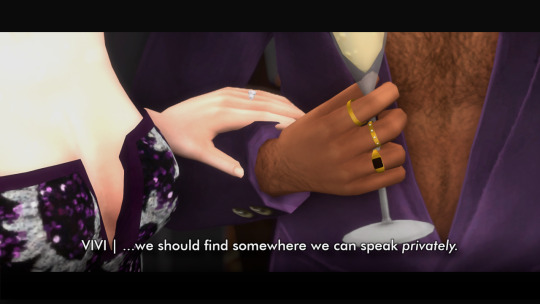
In this scene, there's a lot of chest on display, but when Vivi makes a pass at Julián, we're looking at their hands and not their bodies. This is another escalation, her touching him instead of the other way around. We're seeing her take the lead, which is sexy!!!

In this scene, we get mouths and hands in a single shot. In a wide shot, this moment of him feeding her ice cream might read as cute, but removed from context and zoomed in to just the mouth and hands, it becomes sensual.
Suggestion Three: Linger in the moment, let us see the reaction
A lot of the idioms related to sex and desire suggest a loss of control. Arousal is "getting hot and bothered," having sex is "giving in" to desire. It's not enough just to show something sexy, we also need to see the effect it's having on our characters. Don't be afraid to show your characters getting flustered, stammering, getting caught up in the moment. I think that people are sometimes a little embarrassed about including sex and want to show only the bare minimum. They want it to be sexy, but they also want it to be over and done with. These two desires are almost always at odds with one another -- if you want something to be sexy, don't be afraid to linger in the moment. Show the action, but more importantly, show the reaction.
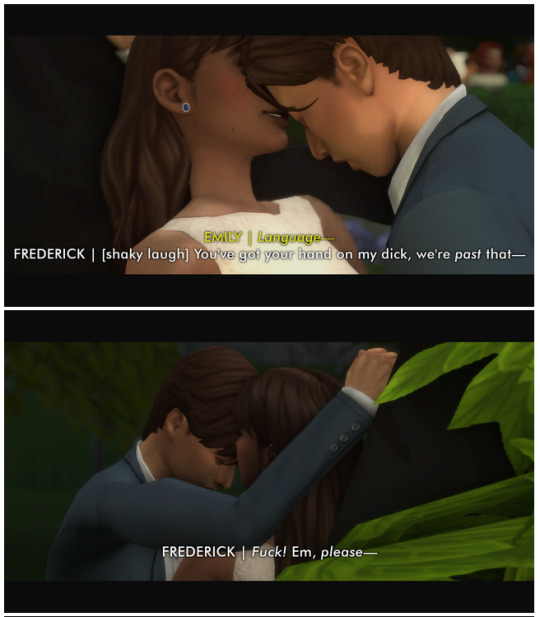
In this scene, we don't need to see any naked bodies (or where exactly Emily's put her hands). It's enough to see Freddy getting progressively more worked up as they make out.
It's especially sexy to show a person who is ordinarily very controlled coming undone.

It's not hard to understand why this was my best-performing post of 2023. Leonor and Andre, both very buttoned-up and in-control people, can't keep their hands off of one another. The facade slips for both of them, they need one another more than they need to discuss whatever important thing they were supposed to be discussing.
Suggestion Four: If you aren't fully comfortable showing sex, you don't have to
Not a ton to say here, but I think it's an important point to end on. If you feel weird and awkward writing sex, downloading sexy poses, and taking sexy screenshots, you don't have to include those things in your story!
Sex positivity doesn't mean everyone's fucking all of the time, it means everyone is expressing the amount of sexuality they are comfortable with. I exclusively wrote erotica/smut for nearly a decade, I am very comfortable including sex in my story. But if that's not you, that's okay! You don't need to include anything you don't want to.
A Random Observation That Didn't Fit Anywhere Else
If you have a scene that features naked or nearly-naked characters that aren't meant to be sexy, you can do the opposite of these things to avoid sexualizing them. Show them in wide shots, don't zoom in close to emphasize any one part of their body, focus on things other than physical reaction -- I've got this whole scene with Leonor in a swimsuit but it's not really sexy in the context. We're not leering at her body, she just happens to be wearing a swimsuit because they're at the beach. Even the physical touch and intimacy in that scene isn't particularly sexy, the emphasis there is on the emotions.
88 notes
·
View notes
Text
Blocking PSA
Blocking someone means they can't view or interact with your main blog, but they can still view your side blog.
If, like me, you keep your Sims content on a side blog, people you block may still be able to see and interact with your Sims blog.
To completely block someone, you need to go into Settings in the left sidebar, scroll down to Blogs in the right side bar, and click your Sims blog.

From there, you need to scroll down to Blocked Tumblrs, and click the pencil.

From there, you're going to type in the name of the blog you'd like to block.

If you block someone, don't leave the door open for them to keep hanging around. I haven't done any testing to see if someone who's been blocked on main can still like/reblog/comment/ask on a side blog, but why find out?
Block 'em everywhere.
10 notes
·
View notes
Note
ok this will be very quick and is written with the assumption that you already understand how reshade/gshade work and the proper order for shaders!
Overall, you want to build a preset in the reverse order that the shaders apply
first: experiment with the shaders that affect the color, contrast, and saturation. Vibrance, colorfulness, tint, multiLUT, etc. (most of the color effects in my personal preset are done with the filmic pass shader). Play around in the settings for each shader you apply until you're happy with the overall effect. Keep in mind that shaders like MXAO and Bloom will also also affect the saturation, but a good baseline for your personal preset is finding an overall look that you like. These shaders use the least amount of processing power and are generally safe to keep on during gameplay, so you can pile on as many as you like. In your finished preset, these shaders will be at the bottom of the load order.
second: one you're satisfied with the colors, duplicate your preset. Keep one as a back-up, and start layering on shaders that affect lighting like DPX and fake HDR. Once again, play around in the settings for each shader until you're satisfied. These shaders are slightly more intensive, so don't go overboard here. Less is often more. In your finished preset, these shaders will be in the middle of the load order.
third: duplicate your preset again. One is a backup, the second is where you'll start experimenting with shaders that offer general graphic improvements. In my personal shaders, I use gaussian blur shaders and then a sharpen shader on top of it to smooth things without losing fine details. This is where you'll apply SMAA and debanding effects. Once again, these shaders can be a little harder on your machine, so you don't want to add a zillion. In your finished preset, these shaders will be toward the top of your load order! (please note that SMAA should go immediately below your DOF shader in the final preset!)
fourth: duplicate the preset! In the new copy, experiment with bloom and ambient lighting. Apply them one at a time and test different settings. One thing that I think leads to a really nice effect is contrasting the tint of your bloom with whatever your color settings were in step one. In my preset, my color shaders desaturate things a bit and add a cool tint, so I add a warm-toned bloom on top of that and the effect is 👌I'd recommend adding some keybindings to all of these shaders so you can easily toggle them for gameplay.
fifth: duplicate the preset again. In the new copy, start playing around with different DOF shaders (if desired). I've noticed that most players don't really touch the defaults on DOF shaders, but I'd really strongly urge you to play around with the different sliders to see what kind of effect they have on the focal distance of your preset and the final look of your game. You're almost certainly going to want to do a mouse-driven DOF, but I recommend playing around with different values for the near and far curves. My current mouse-driven DOF settings make things a bit finicky, but it gives me a nice wide in-focus band that lets me achieve a bunch of different effects just by moving the focal point a little. You'll also want to add a keybinding to your DOF shader so you can toggle it easily. In your final preset, your DOF shader should appear second in the load order, just beneath your MXAO.
sixth: duplicate the preset, and then start playing around with MXAO to add shadows and depth to your preset. once again, you're going to want to add a keybinding to this shader so it can be toggled for gameplay. In your final preset, MXAO should be on the top of your load order.
Other general advice: don't try to build your preset from scratch in one sitting. I would strongly recommend playing and taking screenshots with your preset in each state of development so you can test it in different worlds and lighting conditions and make sure you like the look of it.
Make frequent backups/duplicates, and iterate away! I started making my own reshade preset in late 2021/early 2022, and I'm still making tweaks and changes to it!
I'd recommend @pictureamoebae and @mellindi's reshade/gshade advice and guidance, which is SUPER helpful and written specifically for The Sims!
Do you or any of the lovely Foxbury Institute have tips for creating a gshade preset from scratch? I have favorites but I’d love to create one specifically for gameplay and another one for screenshots. Thank you!
it's not too difficult. you mostly just hit the plus sign at the top, create a preset, then start ticking on/off shaders as you see fit. it's a bit time consuming so it's why most people start with a base and adjust from there.
this vid is for ffiv, but it's mostly the same principle
youtube
15 notes
·
View notes
Text
I think my best advice for making internet friends is to find something specific to complement a person on and ask a follow-up question.
One of my closest internet friendships started because I really loved a museum build that @nexility-sims did, because I really love history and art museums and her set felt exactly right. I told her I loved the authenticity of that specific build and asked if she had gone to school for museums/exhibit design. (at the very least, that's the first conversation I remember having with her!)
good online friendships are built on the back of good conversations, and a good compliment-and-question combo can kick off a good conversation. at the very least, it establishes you in that person's mind as someone who's friendly and interested in what they're posting, and that plants some friendship seeds that may bloom later.
if you have a hard time starting conversations with new people, remember these two c's: complementary and curious.
10 notes
·
View notes
Text

a lot of people say they struggle to dress their male sims, so I threw together a quick visual guide to show how I conceive of men's style.
imo, the two primary axis in menswear are formality and flashiness.
does a character wear tailored suits, watches, and leather loafers? or is he a basketball-shorts-and-sneakers kind of a guy? is he comfortable standing out from the crowd, or does he prefer to dress plainly and go unnoticed?
if you have a solid grasp on your character's personality, it should be pretty easy to figure out where they fall along each axis. that gives you a really solid starting point for making fashion choices in CAS. layer on a favorite color, a few favorite accessories, and a signature item (band t-shirts? colorful ties? sneakers?) and you'll be a long ways toward giving your male sims a distinct visual identity.
the crucial thing is making sure that none of your characters land in exactly the same place on the grid. maybe your protagonists are two preteen boys who are complete fashion disasters who wear sarcastic gamer t-shirts and hoodies every single day. tragic. but if you put one of them in basketball shorts and flip flops and the other in jeans and chunky tennis shoes, their wardrobes will still look and feel distinct to your readers.
I've kept these categories intentionally broad and neutral of specific styles or trends on purpose -- this isn't meant to be a definitive guide to men's style or make any rulings about how formal certain items are. it's meant to give menswear rookies a way to start categorizing men's clothing and make better, more characterful decisions about how to dress their sims.
hope that helps!
37 notes
·
View notes
Text

learned how to create reflective widows in photoshop...my power grows.
youtube
16 notes
·
View notes